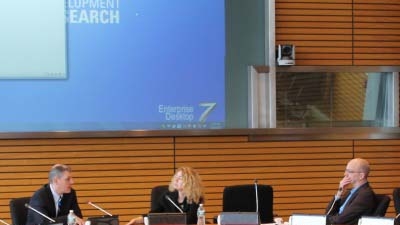In a range of countries there are striking differences in the educational attainment of children from the richest 20 percent of households compared to the poorest 40 percent. And in many countries the remaining gap in achieving universal primary education derives from these differences.
Those findings were discussed by Deon Filmer, lead economist in the World Bank’s research department, at March’s Policy Research Talk, a monthly event held by the department to foster a dialogue between researchers and operational colleagues.
“Documenting inequalities in schooling and learning is an important first step because they help focus policy attention,” said World Bank Research Director Asli Demirguc-Kunt, who hosted the event. “But it’s only the first step, and then comes the question of how to address these inequalities and narrow the gap.”
Filmer’s research draws on a database that covers patterns of educational attainment and enrollment in 96 countries around the globe. The database also includes information on demographics that allow researchers to identify inequalities not only by wealth, but also by characteristics such as gender, disability status, and orphan status.
The data demonstrate that educational inequalities based on wealth are often bigger within countries than between countries. In Western and Central Africa, these inequalities show up early. For example, in Niger only 30 percent of the poor completed the first grade whereas 80 percent of the wealthier had done so. In regions with higher overall levels of attainment like East Asia or Latin America, inequalities show up later in the educational cycle but are still quite high. In Indonesia, for example, almost all children start school, but only 70 percent of those from the poorest quintile complete the ninth grade, compared to virtually all children of the wealthiest households reaching that level.
These inequalities are not limited to wealth: gender and disability also play a role. Gender gaps, in particular, are exacerbated by poverty: females from poorer households face an even larger gap than those in richer households. Those with disabilities also face a substantial gap in educational attainment in developing countries—and in many countries inequalities based on disability status proved to be even larger than those based on household wealth or rural residence, for example.
The good news is that policy makers who want to tackle educational inequalities have effective policy options that are backed up by rigorous research. Filmer discussed the case of Cambodia, where the World Bank worked with the Cambodian government to design and implement a scholarship program targeted at the poor. An evaluation of the program found that a scholarship equivalent to US$45 had a large impact on school attendance, with recipients over 20 percentage points more likely to attend secondary school.

